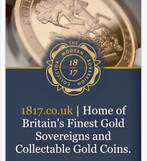Sovereigns of George III dates types mintages varieties and rarity scales.
George III (1760 - 1820)
Born: 4 Jun 1738
Accession: 25 Oct 1760
Married: Charlotte of Mecklenburg-Strelitz
Coronation: 22 Sep 1761
Children: 15
Died: 29 Jan 1820 (81)
Accession: 25 Oct 1760
Married: Charlotte of Mecklenburg-Strelitz
Coronation: 22 Sep 1761
Children: 15
Died: 29 Jan 1820 (81)
Sell Sovereigns
We buy all modern gold sovereigns, from collectors, traders, investors and others.
The standard design for the initial currency Sovereigns depicting King George III and the classic design of St George slaying the dragon engraved by Benedetto Pistrucci was received with great acclaim at the eventual introduction of the modern milled gold Sovereign to the British public on the 5 July 1817, as published in the London Gazette of that date.
The first type obverse depicts the King facing right with a laurel wreath upon his head showing ten leaves to the viewer with coarse hair. The date appears below and the legend. The lettering of the legend is clear of the raised rim. The currency coins are struck with an inverted die axis, the proof versions are usually struck with an upright (en médaille) die axis.
The reverse depicts St George attempting to slay the dragon with a broken lance. The other part of the broken lance lays on the left ground-line with the designers initials BP incuse below it. The Order of the Garter surrounds the design with the motto of the Order upon it. There is an outer raised rim both sides. The edges are always straight grained milled, which is the first time such an edge appears on a British gold coin.
The classic figure of St George slaying the dragon was modelled from life based on an Italian servant working at Brunet’s Hotel, No.25 Leicester Square, where Pistrucci lodged when he first came to work for the Mint in London. This depiction has gone down in numismatic history as one of the most enduring designs ever used upon a coin.
The first type obverse depicts the King facing right with a laurel wreath upon his head showing ten leaves to the viewer with coarse hair. The date appears below and the legend. The lettering of the legend is clear of the raised rim. The currency coins are struck with an inverted die axis, the proof versions are usually struck with an upright (en médaille) die axis.
The reverse depicts St George attempting to slay the dragon with a broken lance. The other part of the broken lance lays on the left ground-line with the designers initials BP incuse below it. The Order of the Garter surrounds the design with the motto of the Order upon it. There is an outer raised rim both sides. The edges are always straight grained milled, which is the first time such an edge appears on a British gold coin.
The classic figure of St George slaying the dragon was modelled from life based on an Italian servant working at Brunet’s Hotel, No.25 Leicester Square, where Pistrucci lodged when he first came to work for the Mint in London. This depiction has gone down in numismatic history as one of the most enduring designs ever used upon a coin.
George III Laureate Head Sovereigns
|
|
|
|


